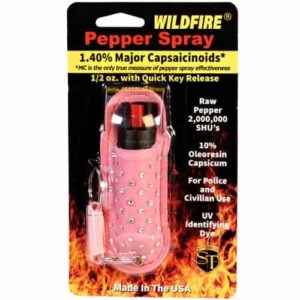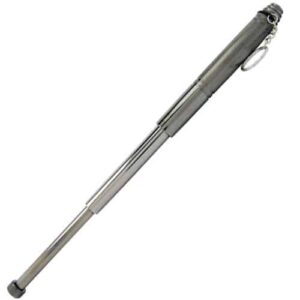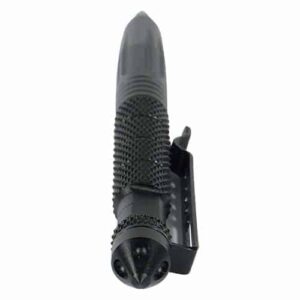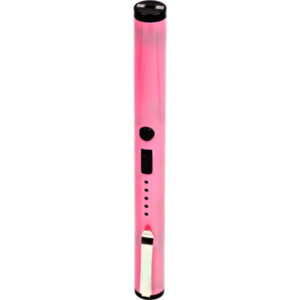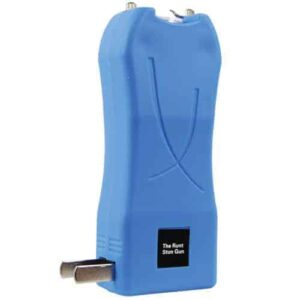You’ve likely heard of the use of pepper spray by law enforcement agencies all over the world, and maybe you’ve even pondered about its impacts and relevant regulations. In the article “Pepper Spray Police”, you’ll navigate through a potpourri of associated essential elements such as the history, legal aspects, and the different views on this powerful tool commonly used by police today. So, put on your thinking cap and prepare to be enlightened as this article breaks down the science, policy, and opinions surrounding pepper spray usage in the modern police force.
Table of Contents
Toggle1. What is pepper spray?
Pepper spray is a tool widely utilized in self-defense and law enforcement. Made from an extract of chili peppers, it temporarily incapacitates an individual by causing burning sensations to the eyes, mouth, and respiratory system.
1.1 Definition
Pepper spray is a type of aerosol spray that contains an inflammatory compound called oleoresin capsaicin. It’s a lachrymatory agent, which means it stimulates your eyes to produce tears. When sprayed into the face of an aggressive attacker or a suspect, it works to incapacitate them by overwhelming their senses, inducing temporary blindness and difficulty in breathing.
1.2 Composition and effects
The primary ingredient of pepper spray, oleoresin capsicum, is extracted from Capsicum plants which includes chilies. When this ingredient comes in contact with the mucous membranes of the eyes, nose, throat, and lungs, it causes immediate dilation of the capillaries, involuntary eye closure, coughing, gagging, and a feeling of suffocation.
2. Introduction to police use of pepper spray
Pepper spray has long been a tool for law enforcement, widely recognized for its ability to de-escalate dangerous situations.
2.1 History of pepper spray as a law enforcement tool
Pepper spray was first used by law enforcement agencies in the 1980s. Before its introduction, police officers had to rely on physical force or lethal weapons to control aggressive suspects. The adoption of pepper spray as a non-lethal alternative has made it easier for officers to subdue attackers or aggressive individuals without resorting to deadly force.
2.2 Reasons for police officers to carry pepper spray
Pepper spray is easy to carry, simple to use, and has a fast effect on suspects. Additionally, in most jurisdictions, its use is considered a lower level of force than other methods like batons or Taser guns, making it a preferable option in many situations.
2.3 Current regulations and guidelines for pepper spray use
While regulations and guidelines vary, many law enforcement agencies have procedural manuals that dictate when and how pepper spray should be used. Typically, pepper spray can only be used in situations where an officer is met with active resistance or threatened with physical harm.

3. Benefits and advantages of pepper spray in policing
Pepper spray provides many benefits for law enforcement officials and for communities at large.
3.1 Non-lethal alternative to firearms
One of the primary benefits of pepper spray is that it provides a non-lethal alternative to firearms. This allows law enforcement to control and detain suspects without causing severe or permanent injuries.
3.2 Effective in subduing suspects
Pepper spray has proven effective at subduing suspects, often doing so more quickly than other means of force. Its incapacitating effects disrupt a suspect’s ability to continue aggressive actions, allowing law enforcement to gain control of the situation.
3.3 Minimal risk of serious injury to suspects and officers
When used correctly, pepper spray poses minimal risk of serious or permanent injury. Though its effects are intensely uncomfortable, they are typically short-lived and leave no lasting harm.
3.4 Long-range capabilities
Pepper spray has an advantage of long-range capability over other non-lethal options like batons or physical restraint. Its range allows officers to maintain a safe distance while still effectively responding to threats.
3.5 Quick deployment and ease of use
Pepper spray is portable, easily accessible, and can be quickly deployed in a situation, making it a practical tool in critical situations. It doesn’t require specialized training or skills to use effectively, making it a go-to tool for many law enforcement officers.
4. Controversies and criticisms surrounding pepper spray use by police
Despite the noted advantages, there are valid concerns and criticisms about the use of pepper spray by the police.
4.1 Instances of excessive use and abuse by officers
There have been several instances where officers have been accused of using pepper spray excessively or unnecessarily. This has caused public outcry and calls for stricter regulations and accountability.
4.2 Potential health risks and complications
Although generally considered safe, pepper spray can pose potential health risks, including respiratory distress. People with preexisting health conditions could potentially experience more severe reactions.
4.3 Disproportionate impact on certain communities
Critics also argue that pepper spray is often disproportionally used on marginalized communities, including racial and ethnic minorities. This has led to widespread calls for better oversight and equitable treatment.
4.4 Lack of standardized training and guidelines
The lack of standardized training and guidelines can lead to misuse or inconsistent use of pepper spray amongst different police departments.
4.5 Calls for stricter regulations and accountability
Public opinion swings toward stricter regulations and greater accountability for the use of pepper spray by police. This sentiment is driven by increased scrutiny of police tactics and a desire for greater transparency.

5. Research and studies on the effectiveness and safety of pepper spray
There is ongoing research examining the effectiveness and safety of pepper spray in law enforcement contexts.
5.1 Studies supporting the use of pepper spray by police
Several studies and reports have found pepper spray to be an effective tool for police, citing its success in deescalating potentially dangerous situations and reducing injuries to both police officers and suspects.
5.2 Research highlighting potential risks and limitations
Conversely, other studies have illustrated possible risks and limitations associated with the use of pepper spray, including potential health risks and the possibility of misuse or overuse by officers.
5.3 Calls for further research and development of alternatives
As our understanding of pepper spray’s effects continues to evolve, researchers and advocates are pushing for additional research into the long-term effects of its use, and the development of alternative non-lethal tools.
6. Comparisons with other non-lethal police tools
There are several other non-lethal tools that police forces use. Here is how pepper spray stacks up against some of them.
6.1 Taser guns
Taser guns are another commonly used non-lethal tool. While they have a longer range than pepper spray, they can be more dangerous, causing heart complications in rare cases.
6.2 Rubber bullets
Rubber bullets are a form of non-lethal ammunition. However, they can cause serious harm if fired at close range or hit sensitive areas like the face.
6.3 Batons
Batons require close proximity to suspects, putting officers at an increased risk. They can also cause more severe injuries than pepper spray.
6.4 Handcuffs and restraints
While handcuffs and restraints are useful for controlling arrested suspects, they do not assist in the initial effort to subdue a resisting individual.
6.5 Differences in effectiveness, safety, and legality
Each of these tools has its own effectiveness, safety, and legal considerations. In general, pepper spray is seen as one of the safer and more effective options, especially when dealing with aggressive individuals.

7. Training and guidelines for police officers using pepper spray
Proper training is crucial for the effective and safe use of pepper spray.
7.1 Basic training and certification process
Officers typically undergo a certification process where they learn the appropriate situations to deploy pepper spray, correct aiming and firing techniques, and post-use protocol like decontamination procedures.
7.2 Continuous education and retraining
Regular retraining is also important to maintain officers’ skills and ensure that they are up to date with any changes in regulations or advice.
7.3 Tactical considerations and best practices
Training also includes tactical considerations, such as safe distances, wind direction, identifying potential threats, and bystander safety. The goal of this training is to limit unnecessary exposure and harm.
8. Case studies of notable incidents involving pepper spray use by police
There have been several high-profile cases involving pepper spray use by law enforcement, particularly during public protests and demonstrations.
8.1 Use of pepper spray during protests or demonstrations
Pepper spray has been used in various instances of civil unrest around the world. While it’s often effective in dispersing crowds, its usage in these contexts can be controversial due to the potential harm to peaceful protestors and bystanders.
8.2 Pepper spray use in encounters with mentally ill individuals
Pepper spray’s intense, disorienting effects can be particularly distressing for individuals with mental illnesses. Cases where it has been used in these scenarios have led to calls for more specialized training for police, particularly in de-escalation and mental health awareness.
8.3 Legal consequences and public opinion
Certain incidents have led to lawsuits based on claims of excessive force, while publicly broadcast cases can shift public opinion and lead to changes in policy.

9. Current debates and discussions on the role of pepper spray in policing
Discussions about police use of force have become increasingly common in recent years, and pepper spray is a part of that debate.
9.1 Police reform and the use of force
Many people are calling for comprehensive police reform, including reevaluating the use of force. The utilization of pepper spray comes under scrutiny in these discussions due to instances of misuse and concerns over potential health risks.
9.2 Activist movements and calls for alternative approaches
Activist movements are increasingly pushing for alternative approaches to law enforcement that minimize harm and emphasize de-escalation. Within these discussions, the role of tools like pepper spray is often debated.
9.3 Perspectives from law enforcement agencies and officers
Law enforcement agencies and officers often defend the use of pepper spray as a necessary tool for ensuring public safety. They argue that it provides a way to control dangerous situations without resorting to potentially lethal force.
9.4 Community engagement and input
Community engagement and input are crucial in formulating responsible and effective policing policies. Public feedback can lead to changes in how and when pepper spray is used.
10. Future developments and potential improvements
The future of pepper spray in law enforcement will likely involve refinement and technological advancement.
10.1 Advancements in pepper spray technology
Advancements in pepper spray technology could make it a more controlled and safer tool. For instance, improvements in delivery systems could lead to more precise targeting, limiting exposure to bystanders.
10.2 Integration with body-worn cameras and other tools
The integration of body-worn cameras and other types of surveillance technology can provide valuable documentation regarding when and how pepper spray is used.
10.3 Enhanced training and accountability measures
Future developments in the use of pepper spray by law enforcement would likely include enhanced training and greater emphasis on accountability measures. These could help address some of the criticisms surrounding pepper spray use and help ensure it is used safely and effectively.




